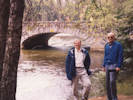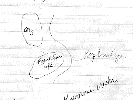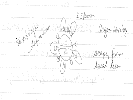 Eastern Mojave Vegetation
Eastern Mojave Vegetation
Tom Schweich
 Eastern Mojave Vegetation
Eastern Mojave Vegetation
| Field Notes (Continued) |
|
Tom Schweich |

Topics in this Article: 1800s 1900s 1910s 1920s 1930s 1940s 1950s 1960s 1970s 1980s 1990 1991 1992 1993 1995 1996 1997 1998 1999 2000 2001 2002 2003 2004 2005 2006 2007 2008 2008 Tour de Swertia albomarginata Mono Lake, August 2008 2009 2010 2011 2012 2013 2014 2015 2016 2017 2018 2019 2020 2021 2022 2023 2024 2025 Contents Literature Cited |
When I first read the field notes of Annie Alexander and Louise Kellogg, I was fascinated by the descriptions they wrote about the places they went and the plants and animals they found there. By publishing my field notes on the Internet I hope to follow a little bit in their tradition. | |
|
|
1995 | |
|
Other articles:
Locations:
Bullock Spring.
Cedar Canyon.
Macedonia Canyon.
Mid Hills.
Wild Horse Mesa.
|
April 1995 Field Trip (?) | |
 "Tom & Paul at the Merced River near the Ahwahnee Hotel, Yosemite, May 14, 1995" "Tom & Paul at the Merced River near the Ahwahnee Hotel, Yosemite, May 14, 1995"
|
||
|
|
Thursday, May 18, 1995 | |
| 8:05AM; mileage 61079, small draw, UTM 11N 451900 4043400, above Lee Pump. | ||
|
Locations: Lee Pump. |
10:10AM, Found 2 Salvia dorrii, along the water line at top of ridge, south of Lee Pump, with Eriogonum, Artemisia, Ephedra viridis, a phlox, Purshia, and Pinyon. | |
|
Locations: Lee Pump. |
9:30AM, Lee Pump, found it, steam powered, pump still here, just hidden, tough hike down canyon, no sign of Salvia dorrii, pumps south up over ridge. | |
| 12:30PM, Identified Ribes velutinum, one of two species of desert Ribes. Also keyed out the Salvia dorrii as ssp. dorrii, because of short hairs along margins of bracts. | ||
|
|
Sunday, May 21, 1995 | |
| 10:40AM, Field Trip Stop 2, Kelso Dunes: Larrea, Ambrosia dumosa, Krameria, Hesperocaulis?, Chorizanthe, Opuntia echinocarpa, white and yellow composites, Opuntia basilaris, Opuntia ramosissima, Spanish needle, lg. yellow camisonia (Camisonia boothii, due to exfoliating epidermis). | ||
| 11:25AM, Field Trip Stop 3. There is a typographical error in the road log. Here there are: Larrea divaricata, Ambrosia dumosa, Hymenoclea salsola, Yucca schidigera, Krameria erecta, Opuntia ramosissima, desert senna, Opuntia basilaris, Opuntia acanthocarpa, Opuntia echinocarpa, Eriogonum fasciculatum, Thamnosma montana, Ferocactus acanthodes, Krameria grayii, Langlosia, Amphipappus (chafe bush), and Bebbia junca. The substrate, i.e., the reason the geologists brought us here, contains a water-lain Bishop Ash. | ||
May 22, 1995 | ||
| 910AM. Fort Rock Spring. Mirabilis multiflora, Ambrosia eriocentra, Lycium cooperi, Hymenoclea salsola, Artemisia tridentata, Chrysothamnus, Guttierezia, Juniperus osteosperma, Yucca baccata, Acacia greggii, Yucca brevifolia, Salvia mohavensis ( ?? Need to verify this find! ), Rhus trilobata, Sphaeralcea ambigua, Opuntia pheacantha, Ephedra viridis. | ||
| The Rock Spring Monzonite (Hornblende, biotite, K-feldspar, Ca-feldspar, Sphene) doesn't work on the Cretaceous/Jurassic diagnostic criteria, but appears to be Cretaceous in age. | ||
| Water recharge is from the New York Mountains. Water is mined at Cadiz. | ||
| Concentric structures … dikes cutting through Mid Hills Adamellite and Rock Spring Monzonite, much younger, may be traces of a younger intrusion not seen at the surface. | ||
| The New York Mountains were a topographic low after Peach Springs time, and maybe a high at Wild Horse Mesa time. | ||
|
Locations: Watson Wash. |
Levee deposits along Watson Wash. Basalts along Watson Wash are set on wash deposits. | |
| Red spotted toads observed at Rock Spring. | ||
| 10:50AM, Field Stop 13. | ||
| Ericameria linearifolia, Ericameria cooperi, Hymenoclea salsola, Yucca schidigera, Acacia greggii, Eriogonum fasciculatum, Ephedra nevadensis, Stephanomeria, Chilopsis linearis, Krameria grayii (rather tall and spiny specimens, just starting to come out and bloom), Gutierezia sarothrae, Tetradymia, Opuntia acanthocarpa, Larrea divaricata, Opuntia ramosissima, Salazaria mexicana, Opuntia engelmannii, Peucephyllum schottii, Ambrosia eriocentra, Salvia dorrii, Salvia mohavensis (??? Verify?) Lepidium fremontii, Dichelostemma, Mamalaria tetrancistra, | ||
| Fossils found at this locality: Medium camel, Small camel, deer, dog, cat, no horses, long-limbed rhinos. | ||
| Hackberry Mountain endogenous, black layer is vitrophyre. Structural monocline, down to the north, east trending. Further down toward Goffs, more complex volcanics. Lacustrine sediments, go all around Hackberry Mountain, below volcanics, and above breccias from Vontrogger Hills volcanism. The rhino here has tall crowned teeth and long legs, look more like wildebeest. Mammals here are equivalent to those at top of Great Plains wedge. | ||
| Peach Springs Tuff is below volcanics of Piute Mtns. | ||
| Stanleya elata, Larrea divaricata, Ambrosia dumosa, Eriogonum inflatum, Yucca schidigera, Eriogonum fasciculatum. | ||
| Sphaeralcea ambigua, Gutierezia microcephala, Lycioum andersonii, Astragalus ++, Yucca brevifolia, Opuntia erincea, Phlox, Lycium cooperi, Calochortus kennedyi, Yucca baccata, Salazaria mexicana, Ericameria linearifolia, Ephedra nevadensis, Opuntia acanthocarpa, Ericameria cooperi, Eriogonum inflatum, Castelleja chromosa, Eriogonum fasciculatum, Hymenoclea salsola, Purshia glandulosa, Lotus, Echinocereus engelmanii, Delphinium parishii, Menodora spinescens, Kraschninikovia lanata, Cryptantha tuberosa, Juniperus osteosperma, Salvia dorrii, | ||
| ||
 Peach Springs Tuff and Tertiary gravels at the mouth of Keystone Canyon, New York Mountains. Peach Springs Tuff and Tertiary gravels at the mouth of Keystone Canyon, New York Mountains.
|
| |
4:00PM,
| ||
| 4:45PM. Vanderbilt Mine. | ||
|
| ||
| 1:10PM. Monocot, head with 3 sepals, petals white, maroon stripes, 6 stamens, opposite petals, anthers versitile, pollen yellow, ovary 3 double wings, style simple, 11N 3894400 647300, ganitic slope with some pyroclastic float. | ||
|
|
Saturday, July 15, 1995Upper Stevens Meadow.Phil Niemer, Lassen Land and Trails Trust. Rosenberg, owners, live in Healdsburg, Nature Conservancy, wanted to fence, Pine Creek not damaged to extent of other parts, easement prevents subdivision, limits development, limits construction, Pine Creek, feeds Eagle Lake, Eagle Lake trout fishery, eliminate Brook Trout, re-establish Eagle Lake Trout. | |
| Property managed intensively, logged twice: 20 years and 8 years ago, selectively logged. Firewood sale for dead lodgepole pine. | ||
| The buildings are from a cattle camp, not used by the Rosenburg family, elevation > 6200 ft (1900 m). | ||
| Flowers, east of Mt Lassen, edge of Cascade Range, west of Modoc Plateau, wet meadow, surrounded by lodgepole pine, and mixed coniferous forest. | ||

|
| |
|
|
Wednesday, October 18, 1995 | |
| Stalks from the previous season were still recognizable. | ||
|
[Previous Page]
[Next Page]
Go to page: [1800s] [1900s] [1910s] [1920s] [1930s] [1940s] [1950s] [1960s] [1970s] [1980s] [1990] [1991] [1992] [1993] [1994] [1995] [1996] [1997] [1998] [1999] [2000] [2001] [2002] [2003] [2004] [2005] [2006] [2007] [2008] [2009] [2010] [2011] [2012] [2013] [2014] [2015] [2016] [2017] [2018] [2019] [2020] [2021] [2022] [2023] [2024] [2025] [A] | ||
| If you have a question or a comment you may write to me at: tomas@schweich.com I sometimes post interesting questions in my FAQ, but I never disclose your full name or address. |
Date and time this article was prepared: 5/12/2025 2:50:41 PM |
|